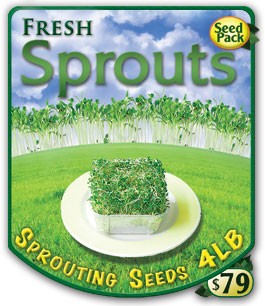|
Home > Guides > Sprouts > Legumes > Beans |
|
How to Sprout Beans | Guide to Sprouting Beans |
|
|
| |
 |
|
Overview |
|
|
|
|
|
| |
|
| |
Bean sprouts typically refer to the popular long and crunchy mung bean sprouts that are often used in Asian soups, stir-fries, and other dishes. These are not the only legumes commonly used for sprouting though, as peas, chickpeas, lentils, fenugreek seeds and others can produce tasty, if somewhat use-specific, sprouts. Additionally, two of the most common sprouts (Red Clover and Alfalfa) are both considered legumes. Like most other sprouts, bean sprouts are high in protein, with most sprouts averaging approximately 30% of their mass as protein. |
|
| |
|
|
| |
Growing Guide
GROWING NOTES
Growing bean sprouts is easy, and requires no additional effort relative to other types. Larger seeds such as peas or chickpeas should be soaked longer (6-8 hours overnight) than small types such as red clover or alfalfa.
Procedure:
- To start your sprouts, you will want to soak your seeds in a bowl of cool water for 4-6 hours, or overnight, making certain that seeds are submersed and not floating on top of the water. This will soften the seed coat and promote germination. After soaking, thoroughly drain off all water. It is wise to rinse seeds immediately after soaking to clean them and wash away an extraneous matter, and again drain off all excess water.
- Wait several hours, then later in that day: Rinse seeds with cool, clean water. Carefully drain off all water so seeds at bottom of sprouter are not covered with water.
- Repeat this process of rinsing with cool water and draining 3-4 times per day as your seeds mature, and even as you begin to harvest and consume them. As your sprouts grow, it is important that they receive good air circulation. Many types of sprouters, such as simple canning jar types, provide good circulation with the tilting motion necessary for complete drainage. Keep your container on your kitchen table or counter, or similar location that has dependable lighting and airflow.
- Once sprouts have reached a desirable state for consumption, they can be transferred out of sprouter and placed under refrigeration to prolong their lifespan. This is not necessary but will slow down the growth process and give you a larger window to eat your sprouts. Continue to rinse and thoroughly drain sprouts as needed. Sprouts should not be allowed to dry out, as they can quickly lose their vitality and nutritional content.
- Clean sprouter thoroughly after use.
|
|
| |
|
|
|
| |
|
|

|
|